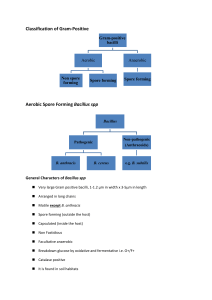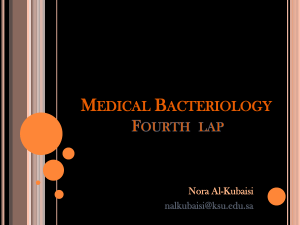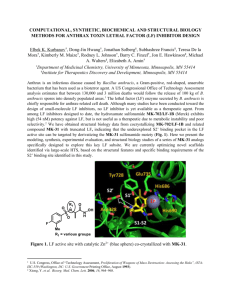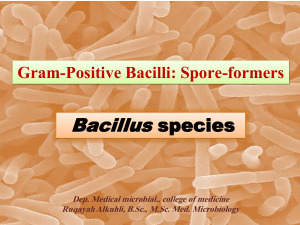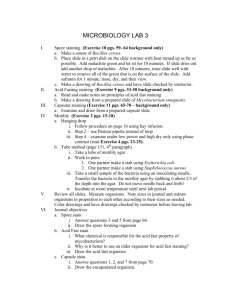Classification of Gram
advertisement
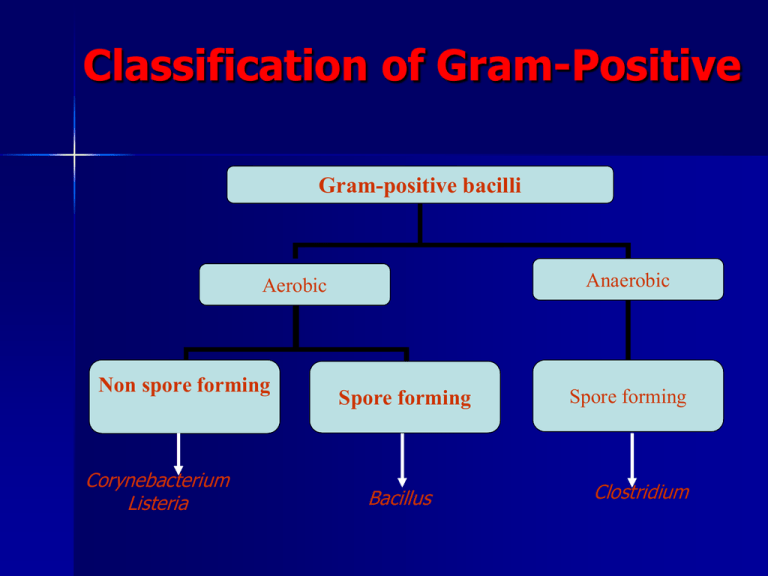
Classification of Gram-Positive Gram-positive bacilli Anaerobic Aerobic Non spore forming Corynebacterium Listeria Spore forming Bacillus Spore forming Clostridium Aerobic Spore Forming Bacillus spp Bacillus Pathogenic B. anthracis B. cereus Non-pathogenic (Anthracoids) e.g. B. subtilis General Characters of Bacillus spp Very large Gram positive bacilli 1-1.2 µm in width x 3-5µm in length Arranged in long chains Motile except B. anthracis Spore forming (outside the host) Capsulated (inside the host) Non Fastidious Facultative anaerobic Breakdown glucose by oxidative and fermentative i.e. O+/F+ Catalase positive It is found in soil habitats Disease Caused by B. anthracis Anthrax Anthrax is an acute infectious disease in man & animal caused by the sporeforming B. anthracis. Anthrax is zoonotic disease Anthrax is occupational disease Direct person-to-person spread of anthrax is extremely unlikely to occur. Types of Anthrax Cutanoues Anthrax (Malignant Pustule) – Most common form of the disease to humans – It is acquired when the spores from the soil or contaminated animal or carcass infect injured skin or mucous membrane usually in face, neck and arm Pneumonic Anthrax (Woolsorters disease) – It is results most commonly from inhalation of spore-containing dust where animal hair or hides are being handled Intestinal Anthrax – It is analogous to cutaneous anthrax but occurs on the intestinal mucosa – Intestinal anthrax is rare & occurs accidentally among butchers and in primitive societies eating meat of infected animals Virulence Factors Poly-D-glutamyl Capsule – Mediates the invasive stage of the infection Anthrax toxin – Mediates the toxigenic stage The toxin consists of three distinct antigenic components, which is thermolabile protein. Edema Factor (EF): necessary for edema production Protective Antigen (PA): induces protective antitoxic antibodies in guinea pigs Lethal Factor (LF): has a lethal effect of anthrax toxin B. cereus B. cereus is a normal inhabitant of soil Also isolated from food such as grains and spices B. cereus causes Two Types of food poisoning – Emetic form or short incubation: It is caused by heat stable enterotoxin Nausea, vomiting and abdominal cramps Incubation period of 1-6 hrs It resembles S. aureus food poisoning – Diarrheal form or long incubation: It is caused by heat labile enterotoxin Abdominal cramps and diarrhea Incubation period of 8-16 hrs Diarrhea may be a small volume or profuse and watery It resembles food poisoning caused by Cl. perfringens In either type, the illness usually lasts < 24 hrs after onset Differential characteristics of B. anthracis & B. cereus B. anthracis B. cereus Hemolysis No hemolysis -hemolysis Motility Non-Motile Motile Identification of Bacillus Spp. Specimen – Pastular exudates in malignant pustule – Sputum in pneumonic anthrax – Stool in intestinal anthrax (also in food poisoning by B. cereus) Stool specimen is emulsified and heated to 80 C to kill non spore forming microorganism Morphology – Macroscopical (Cultural characteristics) – Microscopical (Gram Stain, Spore Stain) Identification of Bacillus Spp. • Cultural Characteristics • Grow on nutrient Agar • On ordinary medium • Grow aerobically at 37C with characteristic mucoid or smooth colonies, which indicates the pathogensity of organism (presence of capsule) • Rough colonies are relatively avirulent • Stab culture on gelatin medium results in inverted fire tree appearance. • Growth on Blood Agar Bacillus species grow well on blood agar showing a double zone of hemolysis B. anthracis, which grows well on blood agar without any hemolytic effect. Cultural Characteristics Nutrient Agar B. cereus Blood Agar B. anthracis Identification of Bacillus Spp. Morphology – Microscopical Stain – Gram Stain Gram positive bacilli Found in chains Non motile Capsulated inside the host Sporulated outside the host Spore is central, oval and non-bulging Spore Stain Procedure 1. 2. 3. 4. 5. 6. 7. 8. 9. Make a heat fixed smear of Bacillus Place the slide on the slide rack Cover the smear with malachite green stain Apply heat for 3-5 min without boiling and drying of the slide Wash the slide gently in running water about 20 S Counterstain with safranin for one minute Gently rinse with water Gently blot the slide dry, no rubbing, and let it air dry and examine with oil immersion optics. Observe red vegetative cells and sporangia, and green endospores and free spores Identification of Bacillus Spp. Spore Stain Bacillus spores are oval & central By spore staining technique (Malachite green & safranin) , the spore appears green while the vegetative cells appear red. Biochemical Tests: 1- Catalase Test All Bacillus species are catalase positive (Remember staphylococci are catalase positive) Starch Hydrolysis (Amylase Activity) Principle – Starch + Iodine – Glucose + Iodine blue color No reaction Nutrient Agar containing 1% Starch + M.O Procedure Amylase Iodine Glucose Appearance of colorless zone around the growth – Inoculate nutrient agar plate containing 1% Starch with the M.O. – Incubate the plate at 37 for overnight – After incubation, flood the plate with Iodine solution Result – Activity of amylase is indicated by a clear zone around the growth while the rest of the plate gives blue color after addition of iodine solution Practical Work Gram Stain Spore Stain Catalase Test Starch hydrolysis
